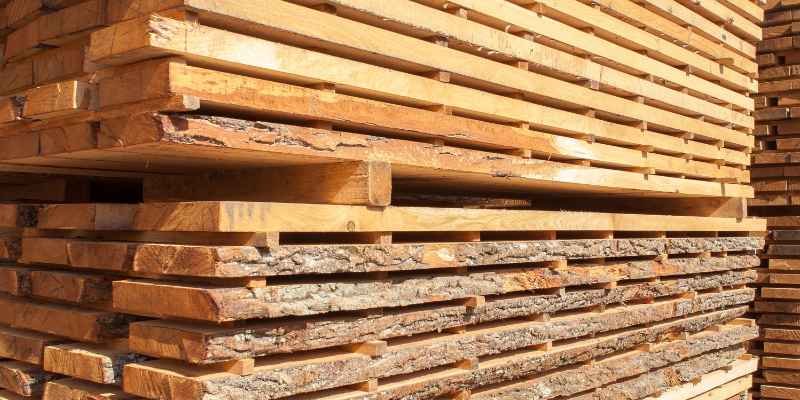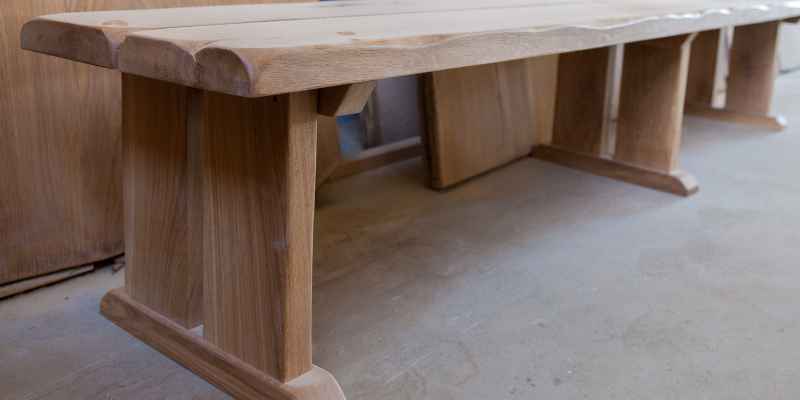Ash wood is an excellent choice for woodworking, known for its staining potential and shock resistance. Despite its susceptibility to insects and fungus, it mimics oak and is economical.
Are you looking for a versatile and economical wood for your woodworking projects? Look no further than ash wood. With its staining potential and ability to mimic oak, ash is a great choice for various woodworking applications. In this blog, we’ll explore the advantages of working with ash wood and discuss its potential drawbacks.
Whether you’re a seasoned woodworker or just starting out, understanding the characteristics of ash wood can help you create stunning and durable pieces for your home or business. Let’s delve into the world of ash wood and discover why it’s a hidden gem in the woodworking community.
The Allure Of Ash Wood In Woodworking
Ash wood has been a favorite choice for woodworking enthusiasts due to its unique characteristics and versatility. From furniture to flooring, ash wood shines in craftsmanship with its distinctive grain patterns and excellent workability. Let’s delve into why ash wood stands out in the world of woodworking.
Why Ash Wood Shines In Craftsmanship
Ash wood stands out in craftsmanship due to its exceptional staining potential and the ability to closely mimic oak. Its shock resistance and solid workability make it a top choice for various woodworking projects. Not to mention, it has been a cost-effective option that was always readily available for artisans.
Comparing Ash To Other Hardwoods
Ash wood offers a density and porosity similar to white oak, making it a reliable workhorse in woodworking projects. While it may have open grains like teak, ash wood’s versatility makes it a preferred option for indoor furniture pieces. However, it is important to note that ash wood may not be suitable for outdoor furniture due to its susceptibility to insects and fungus when exposed to soil.

Physical And Mechanical Properties
Ash wood is favored in woodworking for its staining potential and oak-like qualities, offering great shock resistance and workability. Despite its susceptibility to insects and fungus, it remains a cost-effective and easily accessible material for various projects.
Ash wood is a popular choice for woodworking due to its excellent physical and mechanical properties. This type of wood has a unique combination of density, strength, shock resistance, and elasticity that make it an ideal material for a wide range of woodworking projects. In this section, we will explore these properties in more detail.
Density and Strength:
Ash wood has a density similar to white oak, making it a durable and sturdy material. The wood’s strength is also impressive, with a Janka hardness rating of 1320, which is higher than red oak and maple. This strength makes ash wood an excellent choice for furniture, flooring, and other woodworking projects that require a robust and durable material.
Shock Resistance and Elasticity:
Ash wood is known for its excellent shock resistance and elasticity. The wood can withstand sudden impacts without cracking or breaking, making it an ideal choice for sports equipment like baseball bats and hockey sticks. Additionally, the wood’s elasticity makes it easy to work with, as it can bend and flex without breaking.
In conclusion, ash wood is an excellent choice for woodworking projects due to its physical and mechanical properties. Its density, strength, shock resistance, and elasticity make it a versatile and durable material that can be used for a wide range of applications. Whether you are building furniture, flooring, or sports equipment, ash wood is a reliable and sturdy option that will stand the test of time.
Aesthetic Appeal
Ash wood is prized for its exceptional aesthetic appeal, making it a popular choice for woodworking projects. From its beautiful color and grain patterns to its versatility in finishing and staining, ash wood has a lot to offer in terms of visual appeal.
Color And Grain
Ash wood is known for its light to medium brown color, which can vary slightly depending on the specific species. Its natural hue is often complemented by prominent grain patterns, including straight grains and occasional waves or curls.
The color and grain of ash wood make it suitable for a wide range of woodworking projects. Whether you’re creating furniture, cabinetry, or decorative items, ash wood adds a touch of warmth and character to any design.
Finishing And Staining Potentials
One of the standout features of ash wood is its exceptional finishing and staining potentials. The wood readily accepts a variety of finishes, allowing you to achieve the desired look and feel for your project.
When finished, ash wood can showcase its natural color and grain patterns with a clear coat or enhance them with a stain. From light and natural finishes to dark and rich tones, ash wood offers endless possibilities for customization.
Additionally, ash wood has the unique ability to mimic oak when stained, making it an excellent alternative for those seeking the look of oak without the higher price tag.
In Conclusion
Ash wood’s aesthetic appeal, including its color and grain patterns, as well as its finishing and staining potentials, make it a top choice for woodworking projects. Whether you’re a professional woodworker or a DIY enthusiast, ash wood offers versatility and beauty that can elevate your creations.
Versatility In Projects
Discover the versatility of ash wood for woodworking projects. Known for its staining potential and shock resistance, ash wood is a great choice for crafting furniture pieces. Its open grain texture exudes charm and sophistication, making it a favorite among wood enthusiasts and artisans.
Furniture Making
When it comes to furniture making, Ash Wood is a popular choice due to its strength, durability, and flexibility. Its light color and straight grain make it ideal for creating clean and modern designs, while its ability to mimic oak makes it a cost-effective alternative. Ash Wood is commonly used for making chairs, tables, cabinets, and other types of furniture.
Sporting Goods
Ash Wood is a popular choice for making sporting goods due to its shock resistance and flexibility. It is commonly used for making baseball bats, hockey sticks, and other types of sports equipment. Its light weight also makes it a popular choice for making paddles for canoes and kayaks.
Decorative Items
Ash Wood’s unique grain patterns and light color make it a popular choice for creating decorative items such as picture frames, cutting boards, and bowls. Its ability to take on stain well also makes it a popular choice for creating custom finishes that can match any décor.
In conclusion, Ash Wood is a versatile and affordable option for woodworking projects. Its strength, flexibility, and unique grain patterns make it a popular choice for furniture making, sporting goods, and decorative items. Whether you’re a professional woodworker or a DIY enthusiast, Ash Wood is a great choice for any project.
Working With Ash
When it comes to woodworking, ash wood is a popular choice due to its workability and durability. Working with ash wood requires the use of specific tools and techniques, as well as careful attention to joinery and assembly. Let’s explore the best practices for working with ash wood in woodworking projects.
Tools And Techniques
Working with ash wood requires the use of various tools and techniques to ensure precision and quality in woodworking projects. Some essential tools for working with ash wood include:
- Saws for cutting and shaping
- Chisels and carving tools for intricate detailing
- Planers and jointers for smooth surface preparation
- Clamps for securing pieces during assembly
Additionally, employing techniques such as proper grain orientation, careful sanding, and precise measurements is crucial when working with ash wood to achieve the desired results.
Joinery And Assembly Tips
Effective joinery is essential when working with ash wood to ensure structural integrity and longevity of woodworking projects. Some valuable joinery and assembly tips for working with ash wood include:
- Utilize mortise and tenon joints for strong and durable connections
- Employ dovetail joints for enhancing both aesthetics and strength
- Use wood glue specifically designed for hardwoods like ash for secure bonding
- Pre-drill holes for screws and fasteners to prevent splitting
By implementing these joinery and assembly tips, woodworking enthusiasts can create well-crafted and long-lasting pieces using ash wood.

Sustainability And Availability
Ash wood is a sustainable and readily available option for woodworking projects, making it a popular choice among craftsmen and DIY enthusiasts. Let’s delve into how the sustainability and availability of ash wood play a crucial role in the woodworking industry.
Emerald Ash Borer Impact
The Emerald Ash Borer has had a significant impact on ash trees, leading to a decline in their population. This has raised concerns about the availability of ash wood for woodworking purposes.
Sourcing Responsibly
Woodworkers are increasingly focusing on responsibly sourcing ash wood to ensure the long-term sustainability of this valuable resource. By sourcing from certified suppliers, they can contribute to the conservation of ash trees.
Cost Considerations
Ash wood is a popular choice for woodworking projects due to its availability and affordability. When considering the cost of using ash wood for your projects, it’s important to take into account market trends and budgeting for your specific needs.
Market Trends
Currently, ash wood is a cost-effective option for woodworking projects. Its availability and versatility make it a popular choice among woodworkers. However, market trends can fluctuate, so it’s essential to stay updated on the current pricing and availability of ash wood in your area.
Budgeting For Your Project
When budgeting for a woodworking project using ash wood, consider the following factors:
- Wood Sourcing: Research different suppliers to find the best prices for ash wood in your area.
- Project Size: Calculate the amount of ash wood needed for your project to estimate the overall cost accurately.
- Additional Materials: Factor in the cost of any additional materials, such as finishing products or hardware, when budgeting for your project.
- Labor: If hiring labor for your woodworking project, include labor costs in your budget calculations.
Pros And Cons
Ash wood is a popular choice for woodworking due to its unique characteristics and versatility. Like any other material, it comes with its own set of advantages and disadvantages. Understanding these can help you make an informed decision when choosing the right wood for your woodworking projects.
Advantages Outlined
When it comes to woodworking, ash wood offers several advantages that make it a desirable option for many craftsmen. Some of the notable advantages include:
- Staining Potential: Ash wood is known for its excellent staining potential, allowing woodworkers to achieve a wide range of colors and finishes.
- Shock Resistance: It exhibits great shock resistance, making it suitable for projects that require durability and strength.
- Workability: Ash wood is relatively easy to work with, making it a preferred choice for various woodworking techniques and projects.
- Economical: It has been an economical wood that was always readily available, making it a cost-effective option for woodworking projects.
Notable Disadvantages
Despite its many advantages, ash wood also has some notable disadvantages that should be considered:
- Open Grains: The open grain structure of ash wood can make it challenging to achieve an ultra-smooth texture in furniture pieces.
- Vulnerability to Insects and Fungus: When exposed to soil, ash wood is susceptible to damage from insects and fungus, making it unsuitable for outdoor furniture pieces.
- Maintenance: It may require more maintenance and care compared to other woods due to its susceptibility to certain environmental factors.
Frequently Asked Questions
Is Ash Wood Good For Woodworking?
Yes, ash wood is good for woodworking. It has great staining potential and can mimic oak. It’s shock-resistant and easy to work with. It’s also an economical wood that’s readily available. However, it has open grains like teak, making it unsuitable for ultra-smooth furniture textures, and it’s susceptible to insects and fungus when exposed to soil.
What Is The Disadvantage Of Ash Wood?
The disadvantage of ash wood is its open grains, which can make it difficult to achieve a smooth furniture texture. Additionally, ash wood is susceptible to insects and fungus when exposed to soil, making it unsuitable for outdoor furniture.
Is Ash Wood Expensive?
Ash wood is generally considered to be an economical option for woodworking, with prices varying depending on the grade and source. Compared to other hardwoods, it is not considered to be overly expensive. However, prices may increase if there is high demand or limited availability due to factors such as the emerald ash borer infestation.
Does Ash Make Good Framing Lumber?
Yes, ash makes good framing lumber due to its solid workability, staining potential, and shock resistance.
Conclusion
Ash wood is a versatile and economical choice for woodworking projects. Its staining potential and workability make it popular among artisans. While it may not be suitable for outdoor furniture, Ash wood’s strength and shock resistance make it ideal for indoor applications.
Explore the beauty of Ash wood in your next woodworking project.


